spreading the technology to dadaab and other refugee camps
an interview with bob metcalf
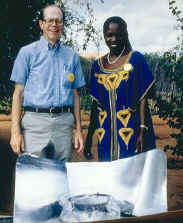 tom sponheim: what is the cooking situation like in dadaab
and the other refugee camps you visited?
tom sponheim: what is the cooking situation like in dadaab
and the other refugee camps you visited?
bob metcalf: this part of kenya is a very decimated area. to find wood to cook, women leave the camps at 4:00 or 5:00 in the morning. you see them coming back about 1:00 in the afternoon, and they've got about three days worth of wood on their backs. it's dangerous out there; there have been a number of rape incidents. when the heavy rains come the wood gets wet and then the price is going to go up. cooking with wet wood isn't very efficient and you get smoke in your eyes.
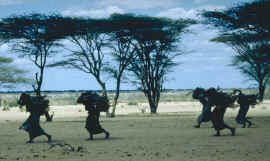 there is quite a problem here with finding enough fuel to cook
with, and there is no affordable plan for how to provide it to
all these refugees. while providing enough food for everyone
is a problem, giving them a way to cook it is an even bigger one.
on a follow-up visit one woman said that she hadn't cooked anything
since we left because she had run out of rations. she would get
her next rations in two days. this situation is only going to
get worse and worse.
there is quite a problem here with finding enough fuel to cook
with, and there is no affordable plan for how to provide it to
all these refugees. while providing enough food for everyone
is a problem, giving them a way to cook it is an even bigger one.
on a follow-up visit one woman said that she hadn't cooked anything
since we left because she had run out of rations. she would get
her next rations in two days. this situation is only going to
get worse and worse.
ts: what other ngos were you working with there?
bm: we're working with gtz (a german ngo), and they are very interested in expanding their solar cooking effort. in the three weeks that we were there, we saw that this type of solar cooking project is kind of glamorous. you just put the food in and it cooks, and, well, it's pretty amazing! they got more and more comfortable with it. one of the staples in kenya is ugali (cornmeal mush), and the ladies will tell you that you can't cook ugali with a solar cooker, because you've got to keep stirring and stirring while it cooks, so that it doesn't stick to the bottom of the pot. the way we cook ugali is to just add equal amounts of cold water and maize meal. you mix it up and you put it in a pot inside a plastic bag and you bake it for two hours. you get two hours of sunshine and it's cooked and it's pretty good. if you let it go for three hours, it starts to brown on the outside a little bit and it has a sweetness, which is better than what they can cook over the fire. there was unanimous approval for the taste using this method. so the panel cooker or the box cooker--either one of them--will work very nicely here.
with the cooperation of gtz then, we gave a workshop for their trainers. these trainers were the ones that were working with improved cookstoves and retained heat cooking, as well as showing people how to plant trees. we had a three-day workshop in each of the camps--hagadera, dagahaley, ifo, and dadaab.
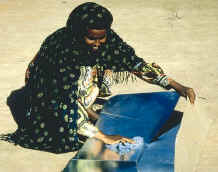 ts: who did the actual teaching?
ts: who did the actual teaching?
bm: gladys, one of the refugee trainers from the kakuma project, was the one who would do much of the initial teaching using various charts. at dadaab we never got any totally clear cooking days that we get here in sacramento, california. but the sun goes straight overhead there. dadaab is right on the equator. we would usually get about 20-30 minutes of sunshine an hour, which is enough to cook at lease one big pot of rations there. at the initial workshop we'd set up some cookers and put in some food. while the food cooked, gladys would go through the basics. she would go through basic solar principles and how to cook and then if the food was done, we'd pull out the food and let them taste it.
we devised some interesting ways to illustrate solar cooking principles. we had a dark lid and a shiny lid and we'd have them touch both of these to understand that dark-colored things get hotter than light-colored ones. then we'd have a pot which was just by itself and one that was in a bag, and they'd feel these. at the end of the workshop, we'd give them their own cooker and show them how to fold and unfold it. if they put the folded cooker up in the rafters, it was out of the way of children and animals. then we'd distribute some uncooked grains for them to take home and try in their cookers.
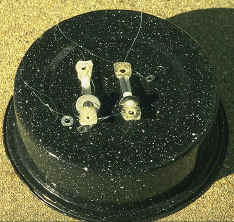 ts: did you teach water pasteurization?
ts: did you teach water pasteurization?
bm: yes, i taught a section on pasteurization. we'd have a discussion on germs. there's no somali word for "germs," so we used the english word "germs." we'd explain that if you heat the water you can kill them. then we'd show the water pasteurization indicators (wapis) and illustrate the steps in making them. we'd eventually put these into the water or the milk. if it reaches pasteurization temperature (70� c), the wax melts and falls to the bottom of the tube. then you know that you've gotten it hot enough to kill off all the germs, and that you can safely drink it.
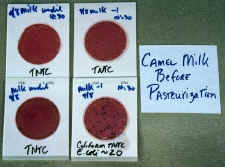 on a follow-up visit, there were three ladies that had used a
cooker to pasteurize camel's milk. i was encouraged that they
seemed to pick up on how pasteurization worked. they also said
the milk tasted better than when they tried to boil it. so it
has an advantage there.
on a follow-up visit, there were three ladies that had used a
cooker to pasteurize camel's milk. i was encouraged that they
seemed to pick up on how pasteurization worked. they also said
the milk tasted better than when they tried to boil it. so it
has an advantage there.
ts: how did this new design affect the form the workshops took?
bm: if some of you have been in solar oven workshops, you know a lot of time is spent building the box, and the lid, and all the variations. but this is quite different because there's the unit over there and all you do is pull it out and set it up. it's already produced for you and you just have to put it together which isn't very difficult at all. the people can see how it's done. you can spend your time teaching the principles of how to cook with it. you put your food in a pot, put that into the plastic bag, place it on the cooker, and face it toward the sun. but it's really not that difficult. many of us have advanced degrees in cooker construction, but this was single-digit addition. the sun comes up directly in the east, so you face it that way in the morning. then about noon, you turn it around toward the west. that's it!
ts: what did you find when you returned for a follow-up visit?
bm: what gladys and i found in the follow-up visits was that the women were finding their cookers very useful immediately. they'd set their food out at 7:30, they'd come to work at the gtz nursery, they'd go back at 12:30 and their food would be cooked--as long as there was enough sun that day. if there wasn't, as gladys explained, you just take it and put it over the fire for a short time; it's already partially cooked. in dagali we had a day with about half sunshine or so. the beans were almost done, but not completely. so we gave the pot to one of the women to take home and finish off. the next day she told us, "it took me only one stick of firewood to finish cooking the beans!" if she had started from scratch it would have taken her six sticks. it costs about a shilling a stick there, and five shillings is a lot of money for them. so they could already start seeing the money savings. the ladies would have their lunch and then they would put on the maize or lentils, face it toward the west, and go to work. not only did they save money, but also it was a lot easier, because you don't have food stuck to the inside of the pot or soot on the outside to clean.
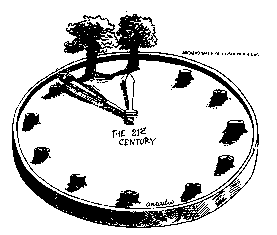 ts: was your worked noticed by any other ngos?
ts: was your worked noticed by any other ngos?
bm: what was really exciting for the care people and the unhcr people was when they took their people and saw that these cookers were in use out there. they talked to these ladies and found that some of them had already taught their neighbors how to use their cookers. they'd cooked a whole variety of things, including some things we hadn't cooked. they'd mixed together the lentils and the maize for instance and cooked that, or the maize and the beans. the ladies had tried a number of things and were quite enthusiastic about it. later we would have these women teach part of a beginning workshop. the administrators could see that out in the neighborhoods there was a lot of interest. "you can cook without fire? i don't believe it! are you going to cook those eggs without water? i can't believe that either."
gladys and i then gave a demonstration in the dadaab camp itself. this camp has the care administrators who are in charge of all the education programs. gladys and i cooked some meat stew and baked some eggs that one sunday we were there. we had a demonstration for about 15 people, including the top care administrator, and we went through the whole thing. i explained the history of solar cookers, and about how sherry cole and barbara kerr came up with a simple cardboard cooker in 1976. i explained how roger bernard's breakthrough solar panel cooker had led to sci's cookit model, which used only a plastic bag and could cook in areas and seasons with high sun angles.
i wanted to give them the idea that there's a rich history--that this didn't just start with the panel, but that there's an awful lot of expertise. i showed the administrators photos of some of the people i've worked with on un projects. they got to know gladys--imagine, a poor refugee from the kakuma refugee camp who was now teaching others refugees how to solar cook. she told them that 1200 families are using these cookers in her camp. and that when the next shipment arrives from nairobi, that number will reach 2000!
dr. bob metcalf can be reached at rmetcalf@csus.edu